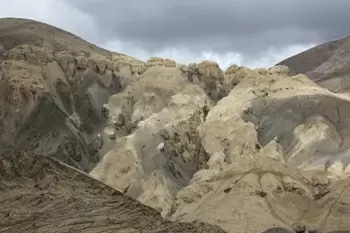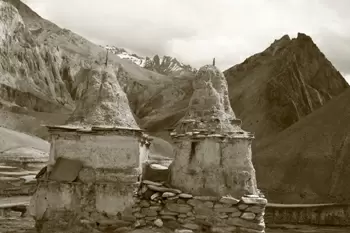Reaching the beautiful heights where your phone network cannot follow you
04-October-2014
Vol 5 | Issue 40
A living testimony of how powers of nature collaborate in beautifying a destination is the Ladakh region of Jammu and Kashmir. It won't be wrong to suggest that God specially curated this cold desert where elements like rains, wind and snow contributed to manicuring its mountains of different hues.
The topaz sky isn't the only element that enchants first time visitor to the "land of high passes", but the majestic presence of mountains in different colours that leave one in awe of nature's mighty presence that is both overpowering and intimidating and yet impressive.
 |
|
The picturesque Moonland stretch enroute to Khaltse in Ladakh (Photos: IANS)
|
Even though it was my second visit to these mountains located at an altitude of 2,750 to 6,670 metres above sea level, it felt as if I was still a stranger to its beauty, admiring the landscape as curiously as I had done five years ago.
But isn't five years a long time for a popular tourist destination to change?
It definitely is, possibly the first signs of weariness of our long-distance relationship were evident in mindless "beautification" drive in its capital Leh, where roads have been dug and umpteen hotels have come up to accommodate tourists.
Yet, it all came back when I headed for a road trip to Kanji village, 150 km away from Leh in the western Ladakh region.
As I slowly left inhabited areas - civil and military - behind, the mountains that so far had been in the background came into forefront from all sides in all their grandeur, with colourful patches adoring its various curves.
So, after passing the "Magnetic Hill" - a popular tourist spot where cars run on the road without their ignition on and "Sangam" or the confluence of the Indus and Zanskar rivers, another tourist hot spot - the real journey began to unfold only afterwards, almost 30 km away from Leh, when the realisation of being in the lap of nature seeped in.
From a distance, these mountains looked like a charcoal painting, with intimate brush strokes defining their various contours and the expansive sky serving as a canvas. As one came closer, the definition of these strokes changed as a chameleon changes its colour.
But it is the sun that takes charge and surprises several times by highlighting an obscure patch of these naked mountains with a completely new hue.
Green patches are rare but whenever in sight, the popular tree plantations compliment the careless meandering of green water Indus that gives you company throughout the journey.
And somewhere between Leh and Khaltse district comes a small stretch - Moonland.
According to locals, the name was given to this stretch because large crevasses in the beige-coloured mountains possibly resemble the terrain of earth's satellite.
This no man's land is often called a photographer's delight, but what it definitely resembles more is the Mount Rushmore National Memorial in Dakota in the US.
But unlike the man-made visages of iconic presidents there, here natural forces like the wind have sculpted unknown faces and natural figurines at the tip of these mountains to make the site a spectacular witness of nature's beauty.
But the real adventure lies in the drive towards Kanji. The contour and colour of mountains change with every turn.
 |
|
A mud structure withered over years
|
Decades of rains, wind and snow have contributed majorly to creating impossible architectural marvels that have taken different shapes and sizes. Delicately placed on several edges, they seem to be guardian angels of these mountains.
As the four-hour journey passes unblinkingly in marveling at the beauty of this remotest side of Ladakh, one's mind wonders whether God had worn a curatorial hat to refine edges of his muse - mountains. The contribution of human kind too can't be ignored in making this journey a memorable experience.
Giving constant company are well-maintained roads by the Border Road Organisation whose sign posts are a delight to read. Like "Better to be Late Mr. than to be Mr.Late."
It was through this journey I rekindled my long-distance relationship. Perhaps, a visit to these quite places where your phone network refuses to give you company is a best bet to find some solace and contemplate about life.
How to Reach: By air, by road from Manali and Kargil in Jammu and Kashmir.
Time to Visit: May to November. Avoid the winter.
Weather: Dry cold during winter and dry hot during summer. - IANS














